Financial Accounting: Ethical Principles and Decision-Making Report
VerifiedAdded on 2021/06/14
|9
|2095
|41
Report
AI Summary
This report provides an in-depth analysis of ethical principles within financial accounting. It begins with an overview of fundamental ethical principles such as respect for autonomy, beneficence, non-maleficence, and justice, and then explores ethical decision-making models, outlining a five-step process for addressing ethical dilemmas. The report identifies key stakeholders, including employees of a meat processing company, and analyzes how they are affected by unethical practices, such as wage discrepancies and lack of benefits. It highlights specific ethical issues related to minimum wage legislation, breaches of ethical principles, and potential violations of labor laws. Furthermore, the report outlines the necessary duties of a financial accountant in such situations, emphasizing the importance of ensuring proper employee classification, accurate salary allocation, and adherence to ethical and legal standards. The report concludes by stressing the importance of maintaining ethical integrity in financial practices.
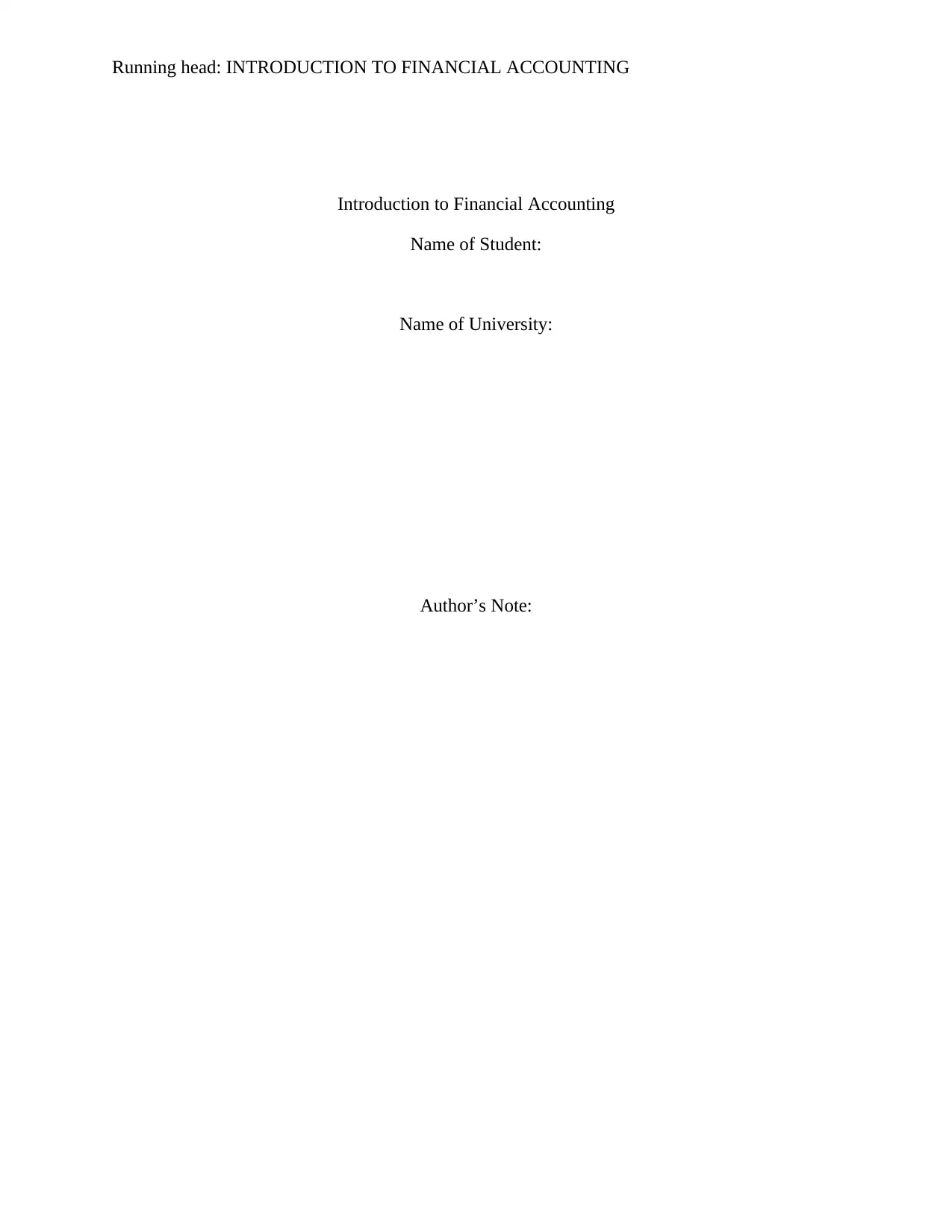
Running head: INTRODUCTION TO FINANCIAL ACCOUNTING
Introduction to Financial Accounting
Name of Student:
Name of University:
Author’s Note:
Introduction to Financial Accounting
Name of Student:
Name of University:
Author’s Note:
Paraphrase This Document
Need a fresh take? Get an instant paraphrase of this document with our AI Paraphraser
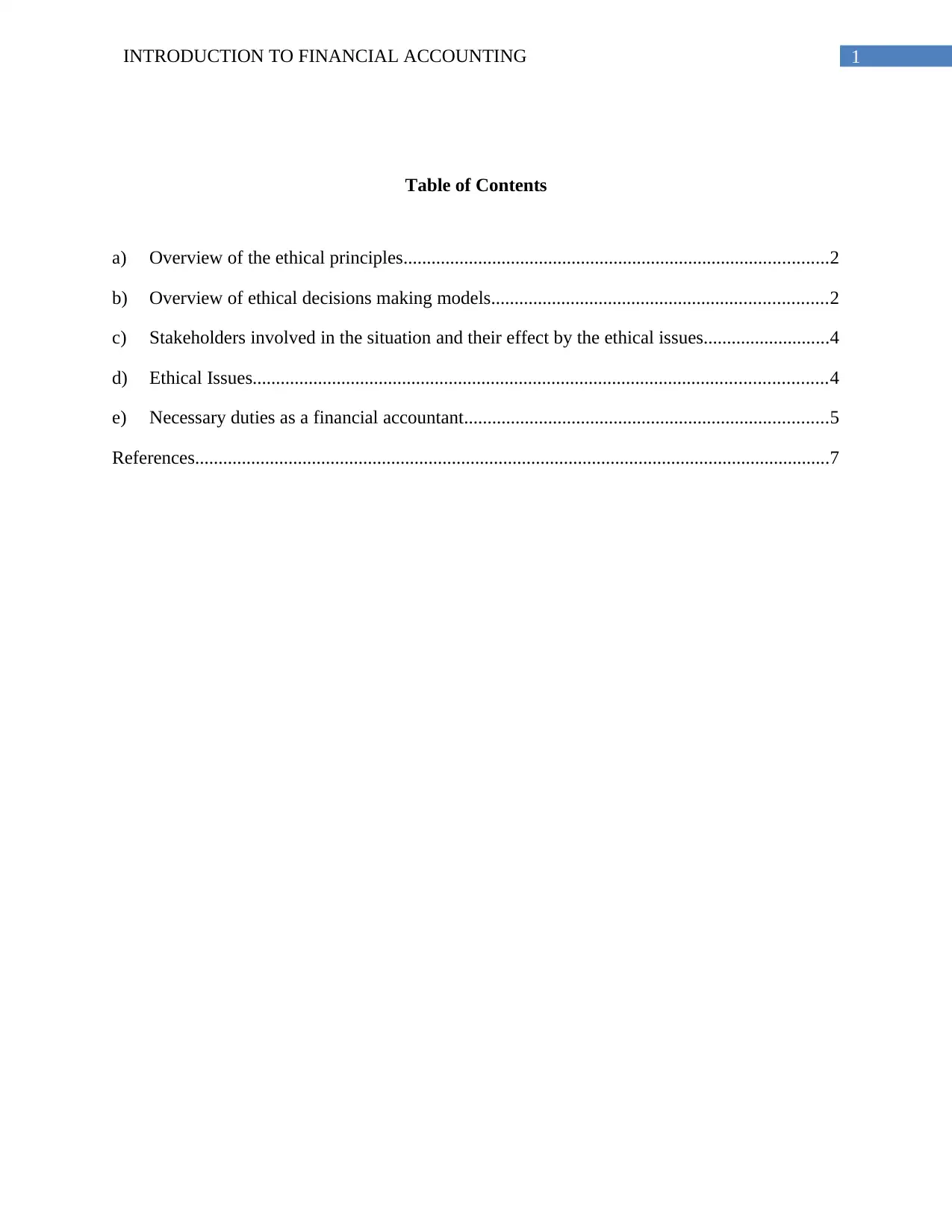
1INTRODUCTION TO FINANCIAL ACCOUNTING
Table of Contents
a) Overview of the ethical principles...........................................................................................2
b) Overview of ethical decisions making models........................................................................2
c) Stakeholders involved in the situation and their effect by the ethical issues...........................4
d) Ethical Issues...........................................................................................................................4
e) Necessary duties as a financial accountant..............................................................................5
References........................................................................................................................................7
Table of Contents
a) Overview of the ethical principles...........................................................................................2
b) Overview of ethical decisions making models........................................................................2
c) Stakeholders involved in the situation and their effect by the ethical issues...........................4
d) Ethical Issues...........................................................................................................................4
e) Necessary duties as a financial accountant..............................................................................5
References........................................................................................................................................7
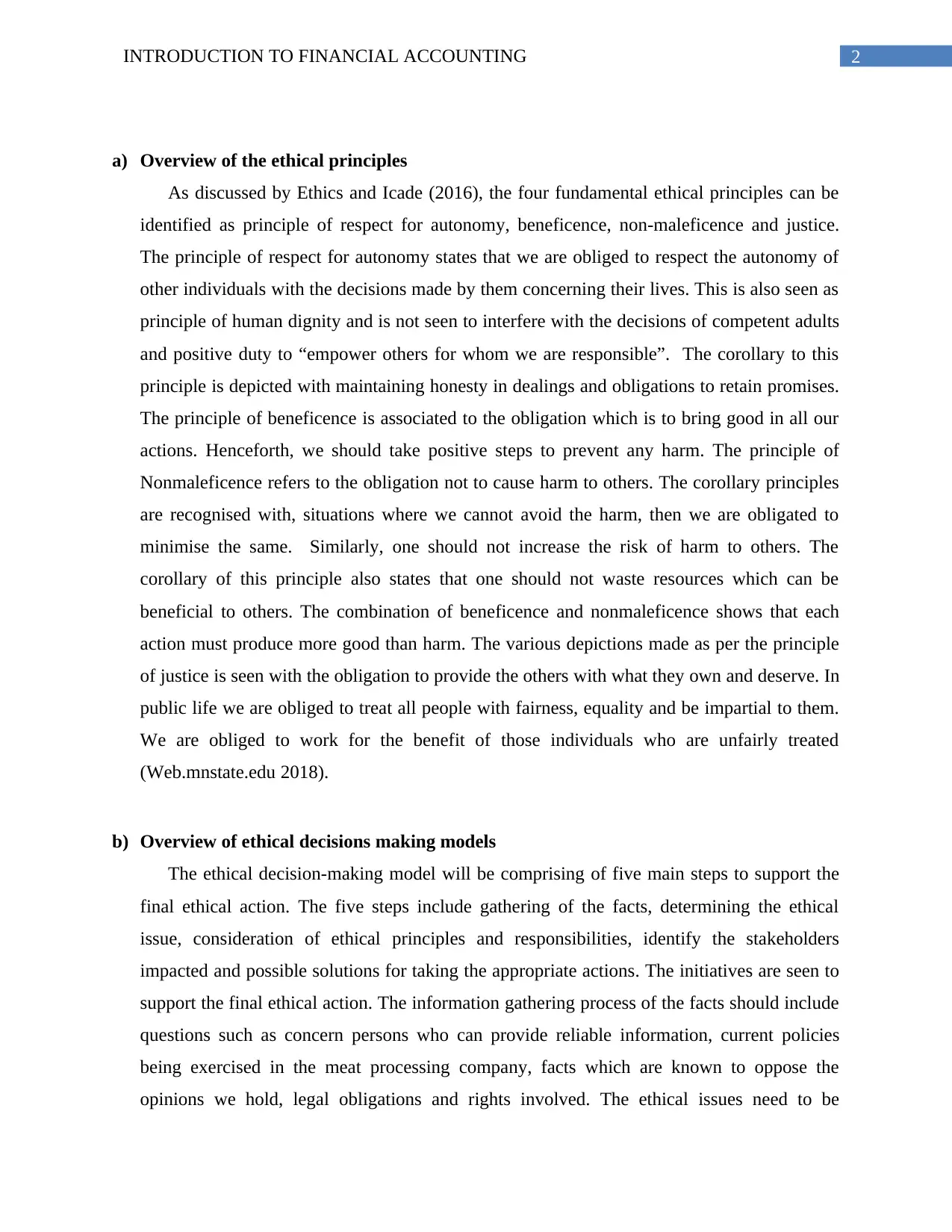
2INTRODUCTION TO FINANCIAL ACCOUNTING
a) Overview of the ethical principles
As discussed by Ethics and Icade (2016), the four fundamental ethical principles can be
identified as principle of respect for autonomy, beneficence, non-maleficence and justice.
The principle of respect for autonomy states that we are obliged to respect the autonomy of
other individuals with the decisions made by them concerning their lives. This is also seen as
principle of human dignity and is not seen to interfere with the decisions of competent adults
and positive duty to “empower others for whom we are responsible”. The corollary to this
principle is depicted with maintaining honesty in dealings and obligations to retain promises.
The principle of beneficence is associated to the obligation which is to bring good in all our
actions. Henceforth, we should take positive steps to prevent any harm. The principle of
Nonmaleficence refers to the obligation not to cause harm to others. The corollary principles
are recognised with, situations where we cannot avoid the harm, then we are obligated to
minimise the same. Similarly, one should not increase the risk of harm to others. The
corollary of this principle also states that one should not waste resources which can be
beneficial to others. The combination of beneficence and nonmaleficence shows that each
action must produce more good than harm. The various depictions made as per the principle
of justice is seen with the obligation to provide the others with what they own and deserve. In
public life we are obliged to treat all people with fairness, equality and be impartial to them.
We are obliged to work for the benefit of those individuals who are unfairly treated
(Web.mnstate.edu 2018).
b) Overview of ethical decisions making models
The ethical decision-making model will be comprising of five main steps to support the
final ethical action. The five steps include gathering of the facts, determining the ethical
issue, consideration of ethical principles and responsibilities, identify the stakeholders
impacted and possible solutions for taking the appropriate actions. The initiatives are seen to
support the final ethical action. The information gathering process of the facts should include
questions such as concern persons who can provide reliable information, current policies
being exercised in the meat processing company, facts which are known to oppose the
opinions we hold, legal obligations and rights involved. The ethical issues need to be
a) Overview of the ethical principles
As discussed by Ethics and Icade (2016), the four fundamental ethical principles can be
identified as principle of respect for autonomy, beneficence, non-maleficence and justice.
The principle of respect for autonomy states that we are obliged to respect the autonomy of
other individuals with the decisions made by them concerning their lives. This is also seen as
principle of human dignity and is not seen to interfere with the decisions of competent adults
and positive duty to “empower others for whom we are responsible”. The corollary to this
principle is depicted with maintaining honesty in dealings and obligations to retain promises.
The principle of beneficence is associated to the obligation which is to bring good in all our
actions. Henceforth, we should take positive steps to prevent any harm. The principle of
Nonmaleficence refers to the obligation not to cause harm to others. The corollary principles
are recognised with, situations where we cannot avoid the harm, then we are obligated to
minimise the same. Similarly, one should not increase the risk of harm to others. The
corollary of this principle also states that one should not waste resources which can be
beneficial to others. The combination of beneficence and nonmaleficence shows that each
action must produce more good than harm. The various depictions made as per the principle
of justice is seen with the obligation to provide the others with what they own and deserve. In
public life we are obliged to treat all people with fairness, equality and be impartial to them.
We are obliged to work for the benefit of those individuals who are unfairly treated
(Web.mnstate.edu 2018).
b) Overview of ethical decisions making models
The ethical decision-making model will be comprising of five main steps to support the
final ethical action. The five steps include gathering of the facts, determining the ethical
issue, consideration of ethical principles and responsibilities, identify the stakeholders
impacted and possible solutions for taking the appropriate actions. The initiatives are seen to
support the final ethical action. The information gathering process of the facts should include
questions such as concern persons who can provide reliable information, current policies
being exercised in the meat processing company, facts which are known to oppose the
opinions we hold, legal obligations and rights involved. The ethical issues need to be
⊘ This is a preview!⊘
Do you want full access?
Subscribe today to unlock all pages.

Trusted by 1+ million students worldwide
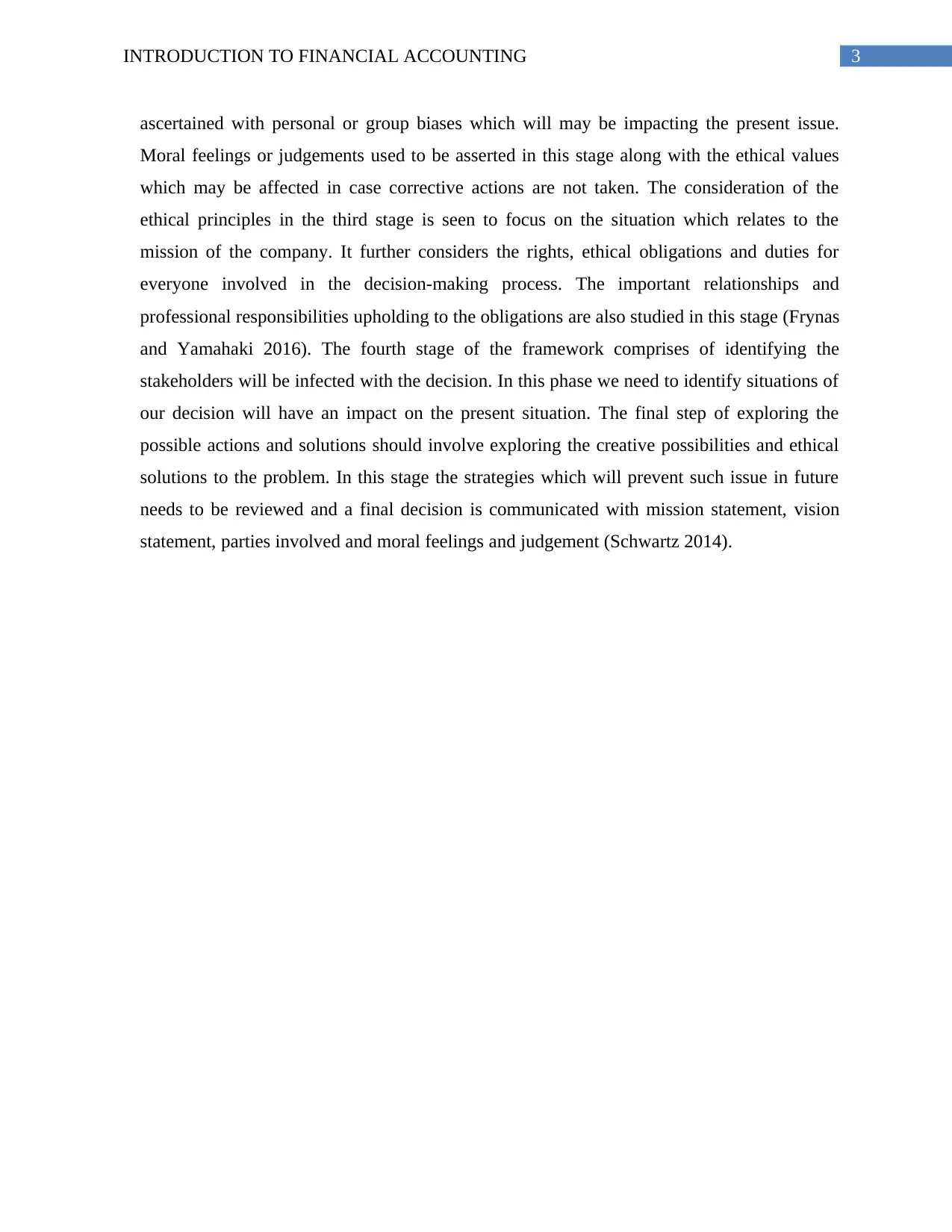
3INTRODUCTION TO FINANCIAL ACCOUNTING
ascertained with personal or group biases which will may be impacting the present issue.
Moral feelings or judgements used to be asserted in this stage along with the ethical values
which may be affected in case corrective actions are not taken. The consideration of the
ethical principles in the third stage is seen to focus on the situation which relates to the
mission of the company. It further considers the rights, ethical obligations and duties for
everyone involved in the decision-making process. The important relationships and
professional responsibilities upholding to the obligations are also studied in this stage (Frynas
and Yamahaki 2016). The fourth stage of the framework comprises of identifying the
stakeholders will be infected with the decision. In this phase we need to identify situations of
our decision will have an impact on the present situation. The final step of exploring the
possible actions and solutions should involve exploring the creative possibilities and ethical
solutions to the problem. In this stage the strategies which will prevent such issue in future
needs to be reviewed and a final decision is communicated with mission statement, vision
statement, parties involved and moral feelings and judgement (Schwartz 2014).
ascertained with personal or group biases which will may be impacting the present issue.
Moral feelings or judgements used to be asserted in this stage along with the ethical values
which may be affected in case corrective actions are not taken. The consideration of the
ethical principles in the third stage is seen to focus on the situation which relates to the
mission of the company. It further considers the rights, ethical obligations and duties for
everyone involved in the decision-making process. The important relationships and
professional responsibilities upholding to the obligations are also studied in this stage (Frynas
and Yamahaki 2016). The fourth stage of the framework comprises of identifying the
stakeholders will be infected with the decision. In this phase we need to identify situations of
our decision will have an impact on the present situation. The final step of exploring the
possible actions and solutions should involve exploring the creative possibilities and ethical
solutions to the problem. In this stage the strategies which will prevent such issue in future
needs to be reviewed and a final decision is communicated with mission statement, vision
statement, parties involved and moral feelings and judgement (Schwartz 2014).
Paraphrase This Document
Need a fresh take? Get an instant paraphrase of this document with our AI Paraphraser
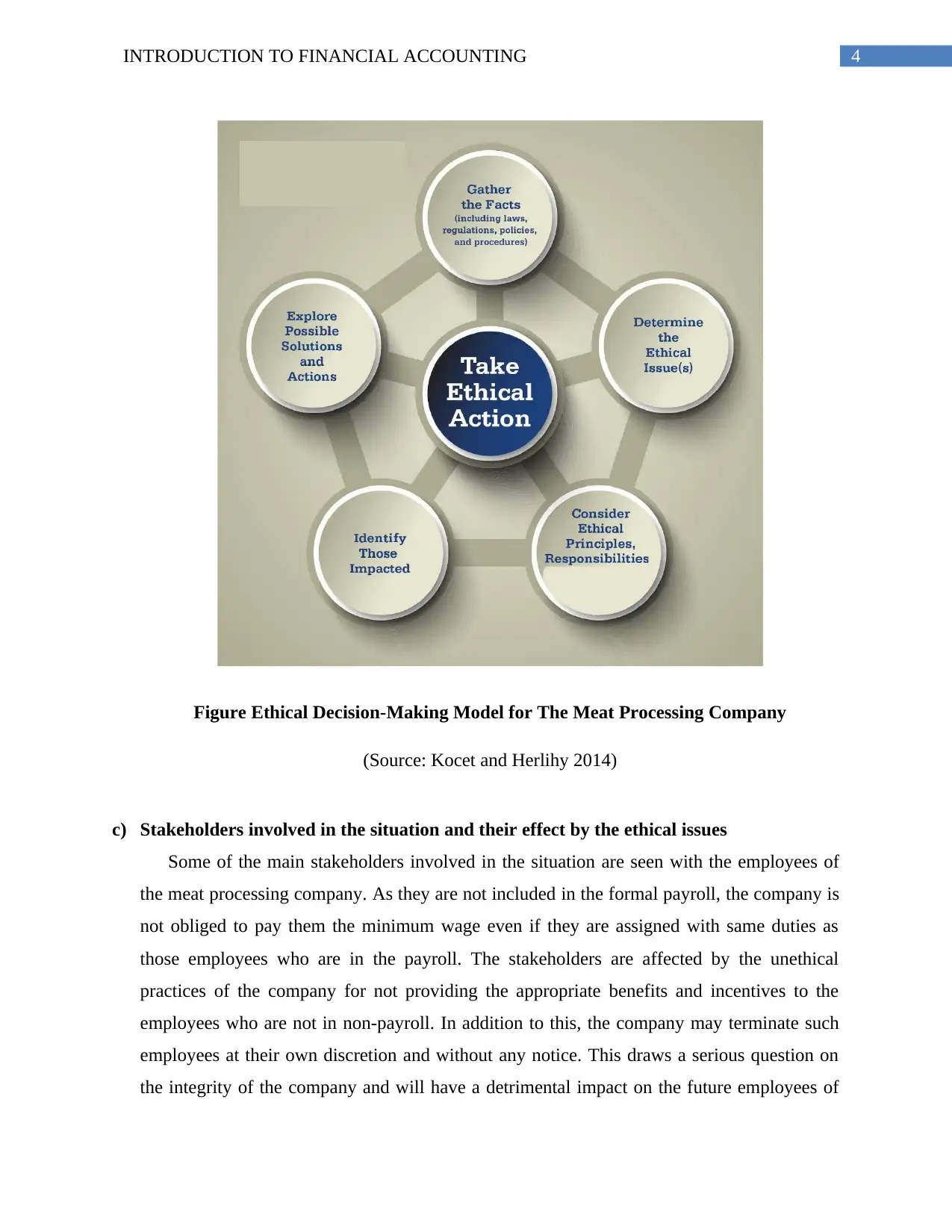
4INTRODUCTION TO FINANCIAL ACCOUNTING
Figure Ethical Decision-Making Model for The Meat Processing Company
(Source: Kocet and Herlihy 2014)
c) Stakeholders involved in the situation and their effect by the ethical issues
Some of the main stakeholders involved in the situation are seen with the employees of
the meat processing company. As they are not included in the formal payroll, the company is
not obliged to pay them the minimum wage even if they are assigned with same duties as
those employees who are in the payroll. The stakeholders are affected by the unethical
practices of the company for not providing the appropriate benefits and incentives to the
employees who are not in non-payroll. In addition to this, the company may terminate such
employees at their own discretion and without any notice. This draws a serious question on
the integrity of the company and will have a detrimental impact on the future employees of
Figure Ethical Decision-Making Model for The Meat Processing Company
(Source: Kocet and Herlihy 2014)
c) Stakeholders involved in the situation and their effect by the ethical issues
Some of the main stakeholders involved in the situation are seen with the employees of
the meat processing company. As they are not included in the formal payroll, the company is
not obliged to pay them the minimum wage even if they are assigned with same duties as
those employees who are in the payroll. The stakeholders are affected by the unethical
practices of the company for not providing the appropriate benefits and incentives to the
employees who are not in non-payroll. In addition to this, the company may terminate such
employees at their own discretion and without any notice. This draws a serious question on
the integrity of the company and will have a detrimental impact on the future employees of
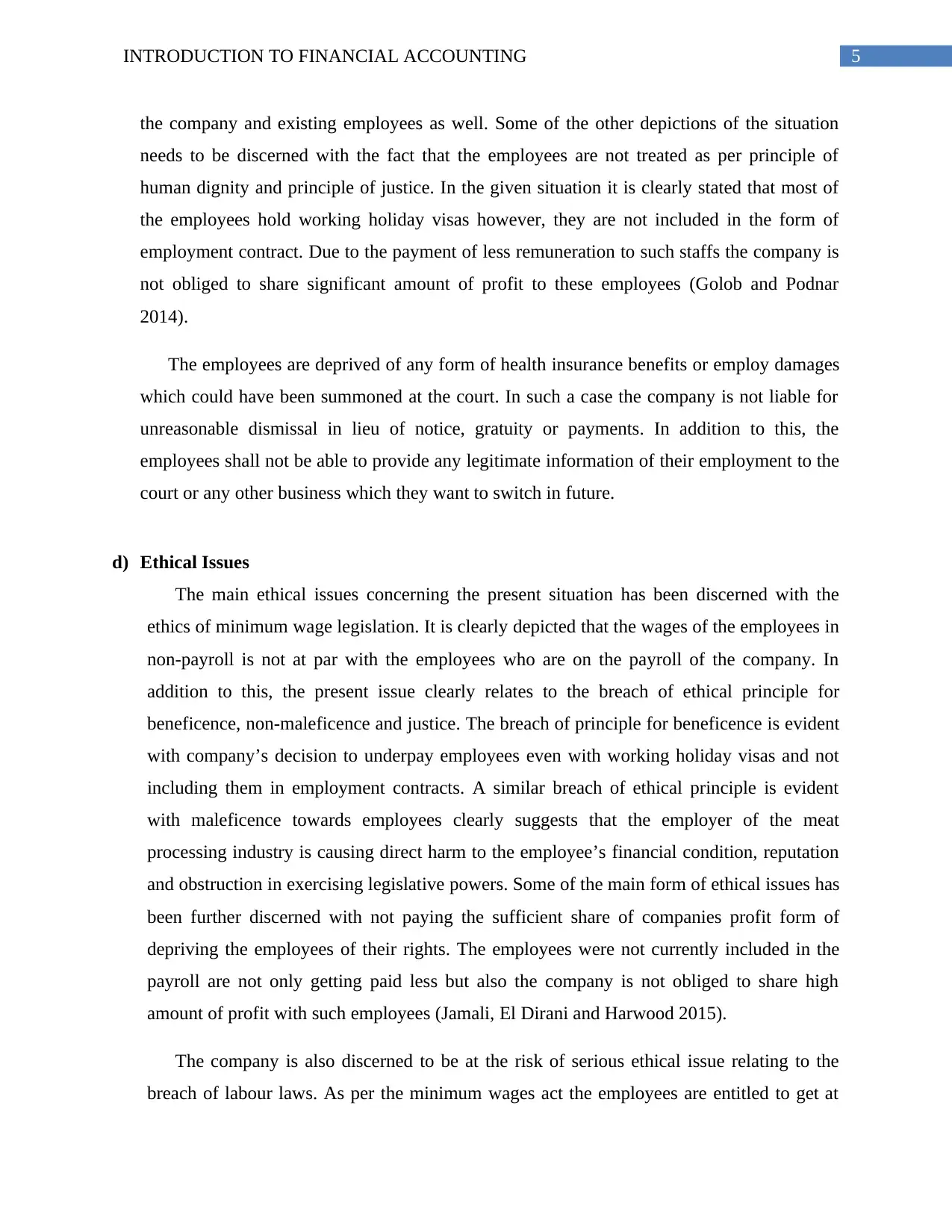
5INTRODUCTION TO FINANCIAL ACCOUNTING
the company and existing employees as well. Some of the other depictions of the situation
needs to be discerned with the fact that the employees are not treated as per principle of
human dignity and principle of justice. In the given situation it is clearly stated that most of
the employees hold working holiday visas however, they are not included in the form of
employment contract. Due to the payment of less remuneration to such staffs the company is
not obliged to share significant amount of profit to these employees (Golob and Podnar
2014).
The employees are deprived of any form of health insurance benefits or employ damages
which could have been summoned at the court. In such a case the company is not liable for
unreasonable dismissal in lieu of notice, gratuity or payments. In addition to this, the
employees shall not be able to provide any legitimate information of their employment to the
court or any other business which they want to switch in future.
d) Ethical Issues
The main ethical issues concerning the present situation has been discerned with the
ethics of minimum wage legislation. It is clearly depicted that the wages of the employees in
non-payroll is not at par with the employees who are on the payroll of the company. In
addition to this, the present issue clearly relates to the breach of ethical principle for
beneficence, non-maleficence and justice. The breach of principle for beneficence is evident
with company’s decision to underpay employees even with working holiday visas and not
including them in employment contracts. A similar breach of ethical principle is evident
with maleficence towards employees clearly suggests that the employer of the meat
processing industry is causing direct harm to the employee’s financial condition, reputation
and obstruction in exercising legislative powers. Some of the main form of ethical issues has
been further discerned with not paying the sufficient share of companies profit form of
depriving the employees of their rights. The employees were not currently included in the
payroll are not only getting paid less but also the company is not obliged to share high
amount of profit with such employees (Jamali, El Dirani and Harwood 2015).
The company is also discerned to be at the risk of serious ethical issue relating to the
breach of labour laws. As per the minimum wages act the employees are entitled to get at
the company and existing employees as well. Some of the other depictions of the situation
needs to be discerned with the fact that the employees are not treated as per principle of
human dignity and principle of justice. In the given situation it is clearly stated that most of
the employees hold working holiday visas however, they are not included in the form of
employment contract. Due to the payment of less remuneration to such staffs the company is
not obliged to share significant amount of profit to these employees (Golob and Podnar
2014).
The employees are deprived of any form of health insurance benefits or employ damages
which could have been summoned at the court. In such a case the company is not liable for
unreasonable dismissal in lieu of notice, gratuity or payments. In addition to this, the
employees shall not be able to provide any legitimate information of their employment to the
court or any other business which they want to switch in future.
d) Ethical Issues
The main ethical issues concerning the present situation has been discerned with the
ethics of minimum wage legislation. It is clearly depicted that the wages of the employees in
non-payroll is not at par with the employees who are on the payroll of the company. In
addition to this, the present issue clearly relates to the breach of ethical principle for
beneficence, non-maleficence and justice. The breach of principle for beneficence is evident
with company’s decision to underpay employees even with working holiday visas and not
including them in employment contracts. A similar breach of ethical principle is evident
with maleficence towards employees clearly suggests that the employer of the meat
processing industry is causing direct harm to the employee’s financial condition, reputation
and obstruction in exercising legislative powers. Some of the main form of ethical issues has
been further discerned with not paying the sufficient share of companies profit form of
depriving the employees of their rights. The employees were not currently included in the
payroll are not only getting paid less but also the company is not obliged to share high
amount of profit with such employees (Jamali, El Dirani and Harwood 2015).
The company is also discerned to be at the risk of serious ethical issue relating to the
breach of labour laws. As per the minimum wages act the employees are entitled to get at
⊘ This is a preview!⊘
Do you want full access?
Subscribe today to unlock all pages.

Trusted by 1+ million students worldwide
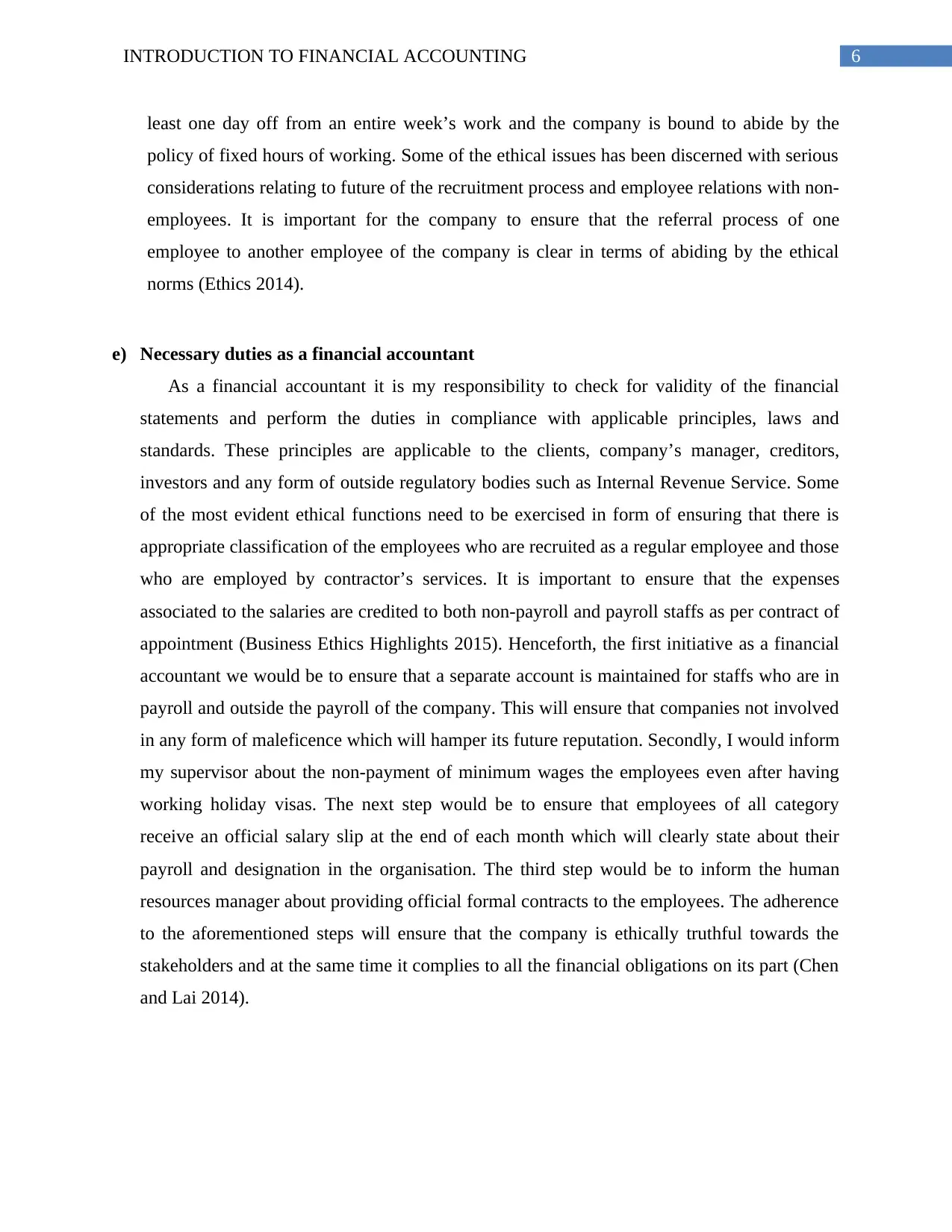
6INTRODUCTION TO FINANCIAL ACCOUNTING
least one day off from an entire week’s work and the company is bound to abide by the
policy of fixed hours of working. Some of the ethical issues has been discerned with serious
considerations relating to future of the recruitment process and employee relations with non-
employees. It is important for the company to ensure that the referral process of one
employee to another employee of the company is clear in terms of abiding by the ethical
norms (Ethics 2014).
e) Necessary duties as a financial accountant
As a financial accountant it is my responsibility to check for validity of the financial
statements and perform the duties in compliance with applicable principles, laws and
standards. These principles are applicable to the clients, company’s manager, creditors,
investors and any form of outside regulatory bodies such as Internal Revenue Service. Some
of the most evident ethical functions need to be exercised in form of ensuring that there is
appropriate classification of the employees who are recruited as a regular employee and those
who are employed by contractor’s services. It is important to ensure that the expenses
associated to the salaries are credited to both non-payroll and payroll staffs as per contract of
appointment (Business Ethics Highlights 2015). Henceforth, the first initiative as a financial
accountant we would be to ensure that a separate account is maintained for staffs who are in
payroll and outside the payroll of the company. This will ensure that companies not involved
in any form of maleficence which will hamper its future reputation. Secondly, I would inform
my supervisor about the non-payment of minimum wages the employees even after having
working holiday visas. The next step would be to ensure that employees of all category
receive an official salary slip at the end of each month which will clearly state about their
payroll and designation in the organisation. The third step would be to inform the human
resources manager about providing official formal contracts to the employees. The adherence
to the aforementioned steps will ensure that the company is ethically truthful towards the
stakeholders and at the same time it complies to all the financial obligations on its part (Chen
and Lai 2014).
least one day off from an entire week’s work and the company is bound to abide by the
policy of fixed hours of working. Some of the ethical issues has been discerned with serious
considerations relating to future of the recruitment process and employee relations with non-
employees. It is important for the company to ensure that the referral process of one
employee to another employee of the company is clear in terms of abiding by the ethical
norms (Ethics 2014).
e) Necessary duties as a financial accountant
As a financial accountant it is my responsibility to check for validity of the financial
statements and perform the duties in compliance with applicable principles, laws and
standards. These principles are applicable to the clients, company’s manager, creditors,
investors and any form of outside regulatory bodies such as Internal Revenue Service. Some
of the most evident ethical functions need to be exercised in form of ensuring that there is
appropriate classification of the employees who are recruited as a regular employee and those
who are employed by contractor’s services. It is important to ensure that the expenses
associated to the salaries are credited to both non-payroll and payroll staffs as per contract of
appointment (Business Ethics Highlights 2015). Henceforth, the first initiative as a financial
accountant we would be to ensure that a separate account is maintained for staffs who are in
payroll and outside the payroll of the company. This will ensure that companies not involved
in any form of maleficence which will hamper its future reputation. Secondly, I would inform
my supervisor about the non-payment of minimum wages the employees even after having
working holiday visas. The next step would be to ensure that employees of all category
receive an official salary slip at the end of each month which will clearly state about their
payroll and designation in the organisation. The third step would be to inform the human
resources manager about providing official formal contracts to the employees. The adherence
to the aforementioned steps will ensure that the company is ethically truthful towards the
stakeholders and at the same time it complies to all the financial obligations on its part (Chen
and Lai 2014).
Paraphrase This Document
Need a fresh take? Get an instant paraphrase of this document with our AI Paraphraser
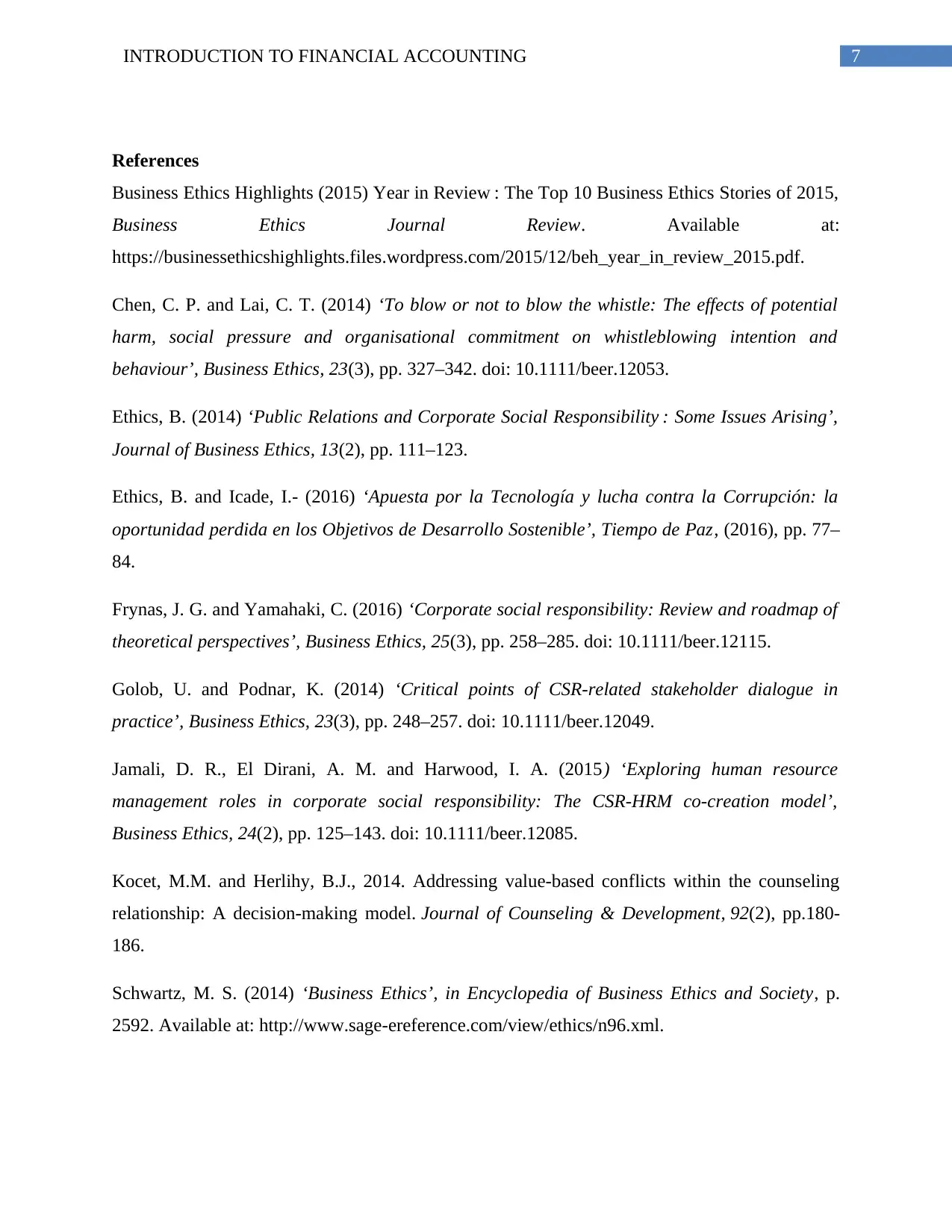
7INTRODUCTION TO FINANCIAL ACCOUNTING
References
Business Ethics Highlights (2015) Year in Review : The Top 10 Business Ethics Stories of 2015,
Business Ethics Journal Review. Available at:
https://businessethicshighlights.files.wordpress.com/2015/12/beh_year_in_review_2015.pdf.
Chen, C. P. and Lai, C. T. (2014) ‘To blow or not to blow the whistle: The effects of potential
harm, social pressure and organisational commitment on whistleblowing intention and
behaviour’, Business Ethics, 23(3), pp. 327–342. doi: 10.1111/beer.12053.
Ethics, B. (2014) ‘Public Relations and Corporate Social Responsibility : Some Issues Arising’,
Journal of Business Ethics, 13(2), pp. 111–123.
Ethics, B. and Icade, I.- (2016) ‘Apuesta por la Tecnología y lucha contra la Corrupción: la
oportunidad perdida en los Objetivos de Desarrollo Sostenible’, Tiempo de Paz, (2016), pp. 77–
84.
Frynas, J. G. and Yamahaki, C. (2016) ‘Corporate social responsibility: Review and roadmap of
theoretical perspectives’, Business Ethics, 25(3), pp. 258–285. doi: 10.1111/beer.12115.
Golob, U. and Podnar, K. (2014) ‘Critical points of CSR-related stakeholder dialogue in
practice’, Business Ethics, 23(3), pp. 248–257. doi: 10.1111/beer.12049.
Jamali, D. R., El Dirani, A. M. and Harwood, I. A. (2015) ‘Exploring human resource
management roles in corporate social responsibility: The CSR-HRM co-creation model’,
Business Ethics, 24(2), pp. 125–143. doi: 10.1111/beer.12085.
Kocet, M.M. and Herlihy, B.J., 2014. Addressing value‐based conflicts within the counseling
relationship: A decision‐making model. Journal of Counseling & Development, 92(2), pp.180-
186.
Schwartz, M. S. (2014) ‘Business Ethics’, in Encyclopedia of Business Ethics and Society, p.
2592. Available at: http://www.sage-ereference.com/view/ethics/n96.xml.
References
Business Ethics Highlights (2015) Year in Review : The Top 10 Business Ethics Stories of 2015,
Business Ethics Journal Review. Available at:
https://businessethicshighlights.files.wordpress.com/2015/12/beh_year_in_review_2015.pdf.
Chen, C. P. and Lai, C. T. (2014) ‘To blow or not to blow the whistle: The effects of potential
harm, social pressure and organisational commitment on whistleblowing intention and
behaviour’, Business Ethics, 23(3), pp. 327–342. doi: 10.1111/beer.12053.
Ethics, B. (2014) ‘Public Relations and Corporate Social Responsibility : Some Issues Arising’,
Journal of Business Ethics, 13(2), pp. 111–123.
Ethics, B. and Icade, I.- (2016) ‘Apuesta por la Tecnología y lucha contra la Corrupción: la
oportunidad perdida en los Objetivos de Desarrollo Sostenible’, Tiempo de Paz, (2016), pp. 77–
84.
Frynas, J. G. and Yamahaki, C. (2016) ‘Corporate social responsibility: Review and roadmap of
theoretical perspectives’, Business Ethics, 25(3), pp. 258–285. doi: 10.1111/beer.12115.
Golob, U. and Podnar, K. (2014) ‘Critical points of CSR-related stakeholder dialogue in
practice’, Business Ethics, 23(3), pp. 248–257. doi: 10.1111/beer.12049.
Jamali, D. R., El Dirani, A. M. and Harwood, I. A. (2015) ‘Exploring human resource
management roles in corporate social responsibility: The CSR-HRM co-creation model’,
Business Ethics, 24(2), pp. 125–143. doi: 10.1111/beer.12085.
Kocet, M.M. and Herlihy, B.J., 2014. Addressing value‐based conflicts within the counseling
relationship: A decision‐making model. Journal of Counseling & Development, 92(2), pp.180-
186.
Schwartz, M. S. (2014) ‘Business Ethics’, in Encyclopedia of Business Ethics and Society, p.
2592. Available at: http://www.sage-ereference.com/view/ethics/n96.xml.
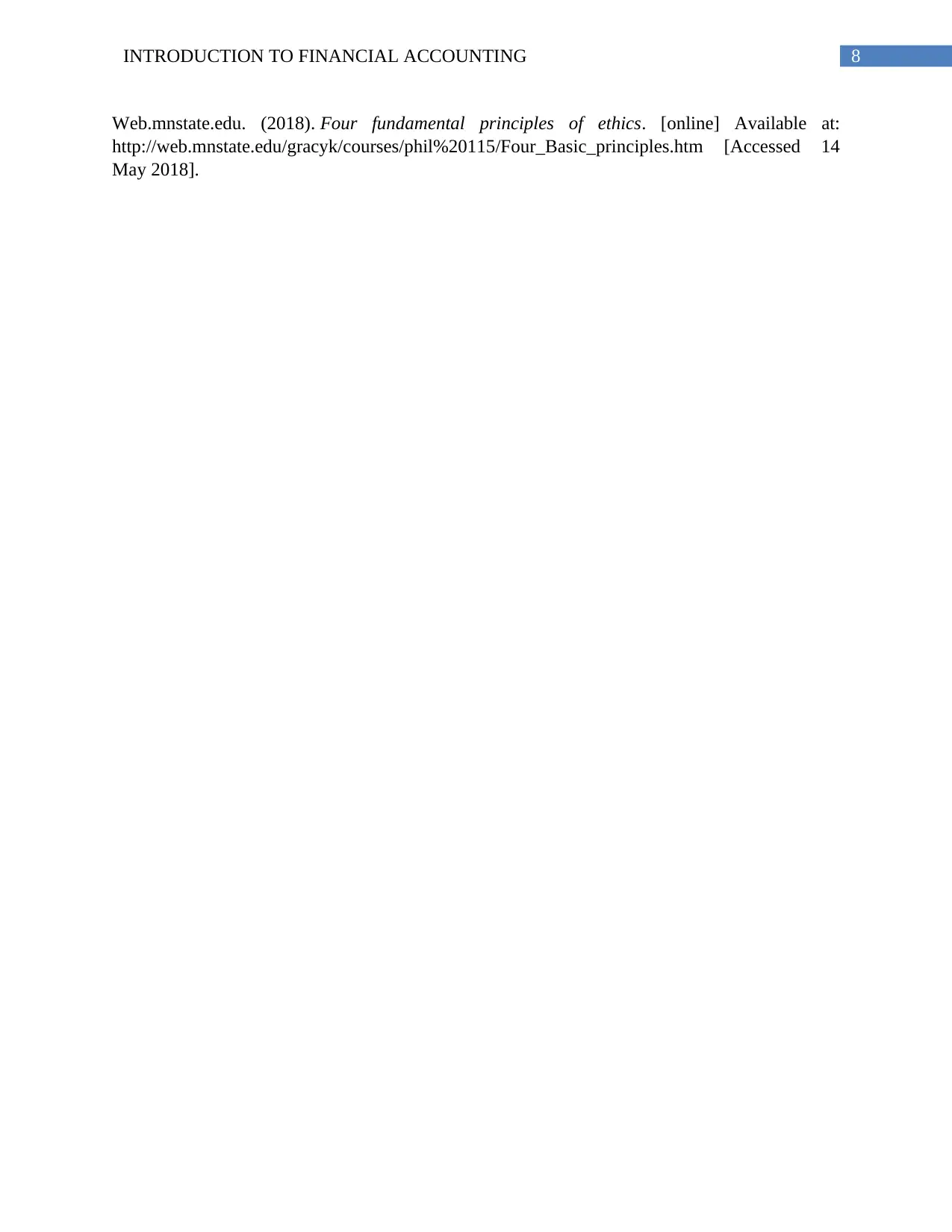
8INTRODUCTION TO FINANCIAL ACCOUNTING
Web.mnstate.edu. (2018). Four fundamental principles of ethics. [online] Available at:
http://web.mnstate.edu/gracyk/courses/phil%20115/Four_Basic_principles.htm [Accessed 14
May 2018].
Web.mnstate.edu. (2018). Four fundamental principles of ethics. [online] Available at:
http://web.mnstate.edu/gracyk/courses/phil%20115/Four_Basic_principles.htm [Accessed 14
May 2018].
⊘ This is a preview!⊘
Do you want full access?
Subscribe today to unlock all pages.

Trusted by 1+ million students worldwide
1 out of 9
Related Documents
Your All-in-One AI-Powered Toolkit for Academic Success.
+13062052269
info@desklib.com
Available 24*7 on WhatsApp / Email
![[object Object]](/_next/static/media/star-bottom.7253800d.svg)
Unlock your academic potential
Copyright © 2020–2025 A2Z Services. All Rights Reserved. Developed and managed by ZUCOL.





